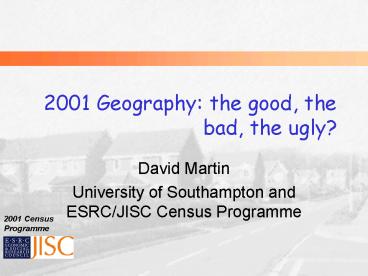2001 Geography: the good, the bad, the ugly - PowerPoint PPT Presentation
1 / 14
Title:
2001 Geography: the good, the bad, the ugly
Description:
... postcode geographies while respecting ward and parish boundaries, ensured that ... postcodes are split across ward and parish boundaries so a perfect match between ... – PowerPoint PPT presentation
Number of Views:51
Avg rating:3.0/5.0
Title: 2001 Geography: the good, the bad, the ugly
1
2001 Geography the good, the bad, the ugly?
- David Martin
- University of Southampton and ESRC/JISC Census
Programme
2
Overview
- What did users want?
- What happened
- The good
- The bad (the ugly)
- What has happened since
- And a few other things
- Ways forward
3
What did users want?
- Postcode and statutory geographies
- Uniformity of population sizes (all above
threshold) - Control over shape (observe settlement pattern
and topographic features) - Internal homogeneity of population
- Compatibility with previous census geographies!
4
What happened
- Entirely new methodology
- Automatic generation of postcode polygons by
Thiessen polygons around Address-Point, clipped
to features - Automated zone design by iterative combination of
postcode polygons until best combination of
statistical constraints
5
Good points
- Postcode and statutory geographies
- Uniformity of population sizes (all above
threshold) - Limited control over shape and homogeneity
- Nationally consistent geography
- Free digital boundaries and lookup tables that
match the OA data on time and to spec!
6
Source scrol.gov.uk
Source nisra.gov.uk
Source national-statistics.gov.uk
7
The bad (the ugly)
- Mismatch with real (or OS?) topographic features
- Some bizarre OA shapes
- Some postcodes still split
- Complete change from 1991
- Differences across UK
- Lack of local input/validation
8
Source neighbourhood.statistics.gov.uk
9
What has happened since
- Embedding within SOAs and use for NeSS
- New datasets e.g. ID2004, but OAs/SOAs are not
neighbourhoods - NeSS not in original design, but cannot be
ignored - Community split over merits of wards and
stability vs. currency
10
And a few other things
- Mean High Water (as 1991), not Extent of the
Realm (as 2001) - Business OAs
- Use MasterMap rather than synthetic polygons
- Sort out a top-quality address infrastructure!
11
Central Newcastle
Severn Estuary
12
Ways forward
- Retain all the principal advantages, while
winning others - Ward-based geographies will never solve our
problems (for more than a couple of years) - Geography and disclosure control issues cannot be
tackled separately
13
Conclusion
- Geography isnt the census
- But when we get it right, it makes the picture
clearer
2001 Census Programme
14
Abstract
- 2001 geography the good, the bad, the ugly?
- David Martin
- University of Southampton and ESRC/JISC Census
Programme - 2001 output geography in England, Wales and
Northern Ireland was produced by an entirely
different methodology to that used for previous
censuses. Automated zone design procedures were
applied to artificially generated postcode
polygon boundaries in order to create a
nationally consistent output geography. This
approach led to the best ever match between
census and postcode geographies while respecting
ward and parish boundaries, ensured that all
output areas contained above-threshold
populations and provided a degree of control over
social homogeneity and geographical shape. The
boundaries were integrated with the postcode and
higher-area lookup tables and were produced to
specification and on time. In many respects this
represents a remarkable series of successes.
However, the absence of definitive postcode
boundaries and limited input of topographic map
features nevertheless led to many output areas
having highly irregular shapes. Some postcodes
are split across ward and parish boundaries so a
perfect match between census and postcode
geographies was not possible, nor do they always
respect social divisions apparent to those who
know an area well. The complete change of
methodology made comparison with 1991 enumeration
districts very difficult and the automated
process provided no opportunity for local
consultation on boundary placement. Subsequent
to the census, the output area boundaries have
been further aggregated to create the super
output areas used by the Neighbourhood Statistics
Service and many users have been encouraged by
the promise of boundary stability, yet important
decisions are still to be made regarding the
maintenance strategy for the 2001 output areas.
Key to 2011 census output will be the very
challenging need to address the principal
shortcomings of the 2001 geography without losing
its major advantages.































